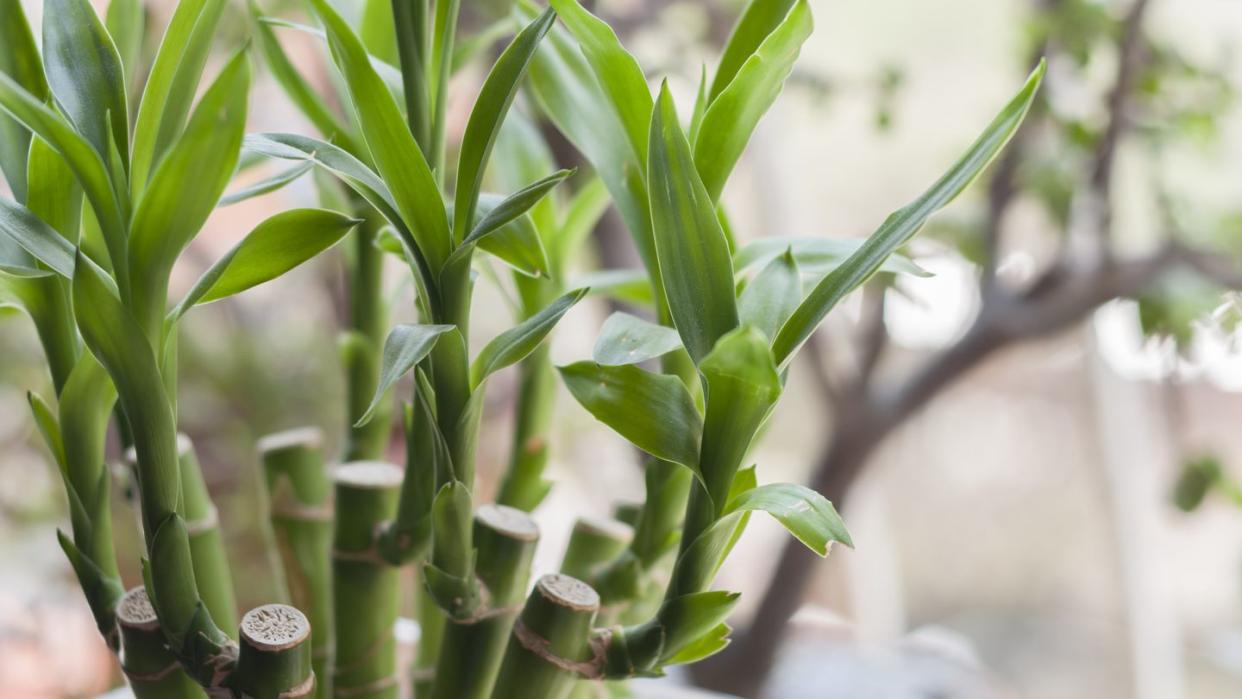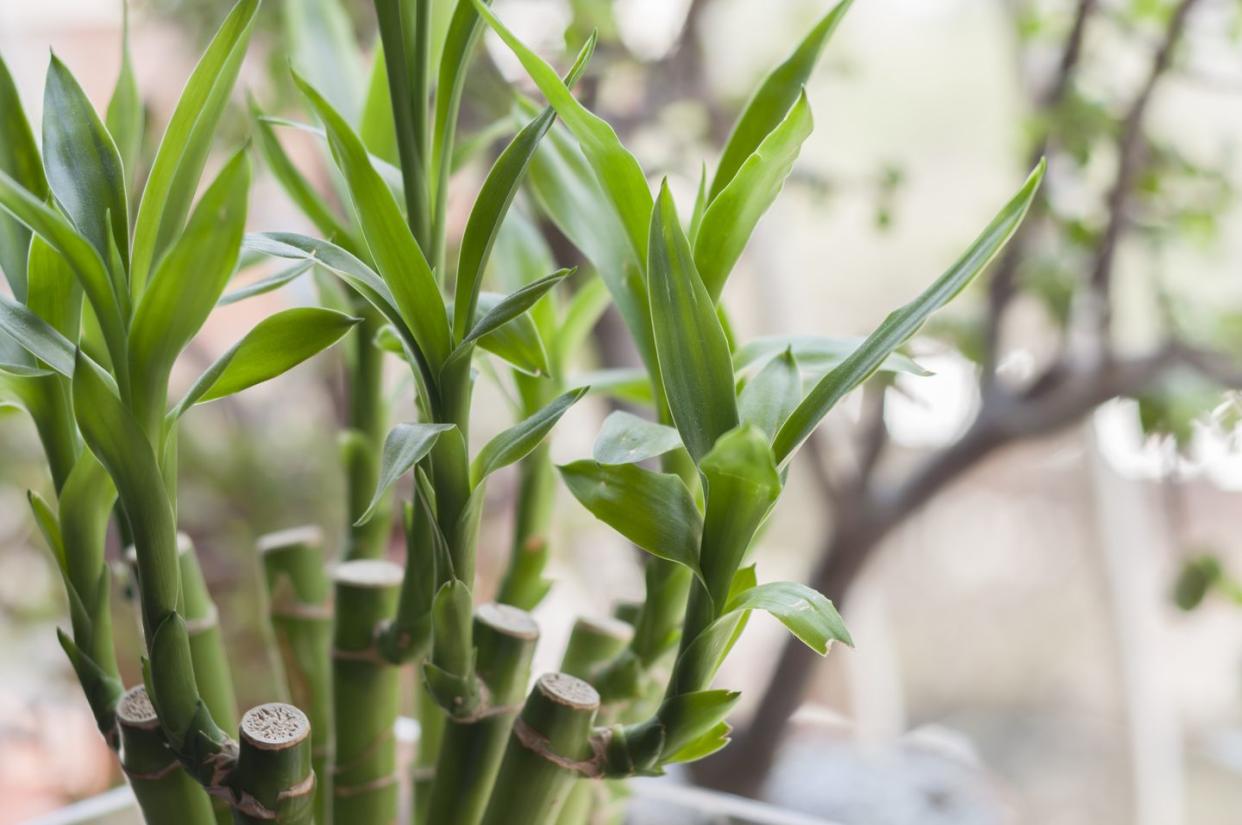Anyone Can Keep This Lucky Plant Alive

"Hearst Magazines and Yahoo may earn commission or revenue on some items through these links."
[table-of-contents] stripped
A four-leaf clover, a horseshoe, a vibrant rainbow that really shows off Roy G. Biv—let’s face it: Whether you believe in good luck or not, there are some serendipitous symbols that bring smile-inducing good vibes in your life. If you want to turn that sentiment into a permanent fixture in your home, the lucky bamboo plant is here to help. But while lucky bamboo is known to bring good fortune, there’s more to this easygoing indoor plant than meets the eye. Officially known as Dracaena sanderiana, this tropical plant is typically found anywhere from West Central Tropical Africa to North East Angola. Believe it or not, lucky bamboo plants aren’t technically bamboo: They’re actually part of the asparagus family.
Regardless of what family it’s in, there’s still a lot to be admired about the lucky bamboo plant. “Lucky bamboo is not only aesthetically pleasing, but [it’s] also known for its ease of care, making it ideal for both gardening novices and enthusiasts,” Samuel Davis, CEO of London Gardeners, says. You can grow it as a potted houseplant or as a cutting in a vase of chlorine-free water. Want to learn more about this prosperous plant? Read on for everything you need to know about the lucky bamboo plant, from its special meaning to the best care tips.

Meaning of Lucky Bamboo Plants
There’s a reason why a lucky bamboo plant is considered, well, lucky: Traditional Chinese cultures believe that having (and gifting) bamboo can bring good fortune. However, this plant isn’t a one-luck-fits-all situation. According to Chinese tradition, the number of stalks on your lucky bamboo plant signifies good fortune for different areas of your life.
Two Stalks: Love
Three Stalks: Longevity and Joy
Five Stalks: Harmony and Balance
Six Stalks: Wealth
Seven Stalks: Health
Eight Stalks: Development and Growth
21 Stalks: The perfect blend of harmony, wealth, health, happiness, love, prosperity, and good fortune.
Avoid bamboo plants with four stalks. In Chinese tradition, the number four symbolizes death and is considered a bad omen. (Translation? A lucky bamboo plant with four stalks isn't so lucky!)
Lucky Bamboo Plant Care
In addition to being incredibly resilient—making this one plant that’s really hard to kill—it’s also pretty easy to care for. It grows best in USDA Plant Hardiness Zones 10a and 10b
Sunlight and Water
“It thrives in indirect sunlight and requires clean, purified water without chlorine—a simple change that ensures its health and vitality,” Davis adds. “We recommend changing the water every two weeks and using a pot with ample drainage to prevent root rot, which is a common issue with this plant.”
Humidity
You can place rocks at the bottom of your lucky bamboo plant’s container to provide the perfect place for the roots to grow.
Fertilizer
If you want to really double down on your plant health, add a weak liquid fertilizer, according to the NC State University Extension. (That said, you should stop using fertilizer if your bamboo’s leaves begin to yellow.)
How to Propagate a Lucky Bamboo Plant
Though lucky bamboo plants can last a long time, you might notice that older ones can get a little limp and straggly over time. Don’t worry: You can keep the good fortune alive by propagating. To start, cut a healthy main cane from your existing plant and remove any superfluous leaves. Place it in a cup with a few inches of water, and wait until it produces roots. From there, you can plant your new lucky bamboo plant in a different container and watch it grow.
Are Lucky Bamboo Plants Toxic?
Lucky bamboo plants might be a beacon for health, wealth, and prosperity, but they shouldn’t be consumed. Not only is this green toxic to pets, but it also contains saponins, which are somewhat poisonous to humans. (In fact, the NC State University Extension says ingesting these plants can result in vomiting, depression, and hypersalivation, among other symptoms.) To err on the side of caution, keep your lucky bamboo plant on a shelf, far away from small hands and mouths.
FAQs
Do Lucky Bamboo Plants Grow in Water?
Well, it depends on who you ask. “It’s often grown just in a vase of water, but it grows equally well in potting mix,” Justin Hancock, Costa Farms horticulturist, explains. “If you keep it in a vase of water, it’s helpful to rinse out and wash the vase every month or two to help prevent algae growth.” Meanwhile, others say that adding pebbles or small stones to your planter can help keep them upright.
Where Should I Put Lucky Bamboo in My House?
Indoor lucky bamboo plants prefer spots that get a moderate amount of indirect sunlight with an average to above-average relatively humidity. Or, as Hancock puts it, “If you’re comfortable, it probably is too.” Consider placing your bamboo plant on a bookshelf or in your living room, bedroom, or home office.
Can You Put Your Lucky Bamboo Plant in Direct Sunlight?
Generally, bamboo plants do best in slightly shady areas or indirect sunlight. While you can try to place them somewhere brighter, you’ll want to keep a close eye on them. “If you see the stalks start to turn golden yellow in color, it often means it dried out,” Hancock explains. “Unfortunately, once the stalks go yellow, that stalk will not recover.”
How Long Does Lucky Bamboo Last?
Lucky bamboo plants are perennials, according to the NC State University Extension, which typically means a plant returns season after season. Lucky bamboo will live for more like one to two years—longer if it’s planted in soil than if it’s grown in water.
Follow House Beautiful on Instagram and TikTok.
You Might Also Like
